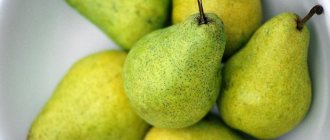Nuts are included in the list of foods prohibited during lactation due to the potential threat of allergic reactions in infants. But it is important for a woman to eat a varied diet, and this product is a source of energy and strength for a nursing mother and baby. So are hazelnuts allowed during breastfeeding, or is it even better not to eat this type of nut?
Hazelnuts contain many useful substances, but is it really that useful for a woman while breastfeeding?
Can I eat hazelnuts while breastfeeding?
Unfortunately, there is no consensus among experts about the benefits or harms of hazelnuts for the body of a woman and baby. Some doctors believe that due to its valuable qualities it is necessary during lactation. Others advise limiting it to minimal use.
At the same time, hazelnuts contain many useful substances. The nut helps strengthen the immune system. Hazelnuts contain protein and other beneficial substances. This manifests itself in improved metabolic processes.
Is it possible to eat hazelnuts during breastfeeding? The nut can benefit the body of mother and child. Thanks to the consumption of nuts, a woman recovers faster after childbirth, and the baby receives a lot of useful substances through breast milk.
But like all nuts, hazelnuts are a product with an increased risk of allergies. If an ordinary person can freely include it in their diet, then a nursing mother should approach its intake responsibly, taking into account all the pros and cons.
Nut composition
Hazelnuts are rich in vitamins A, E and C. There are much more of them than in black currants and lemon. The nut contains iron, cobalt, potassium, and magnesium. Hazelnut proteins include 20 amino acids needed by humans, in an ideal ratio.
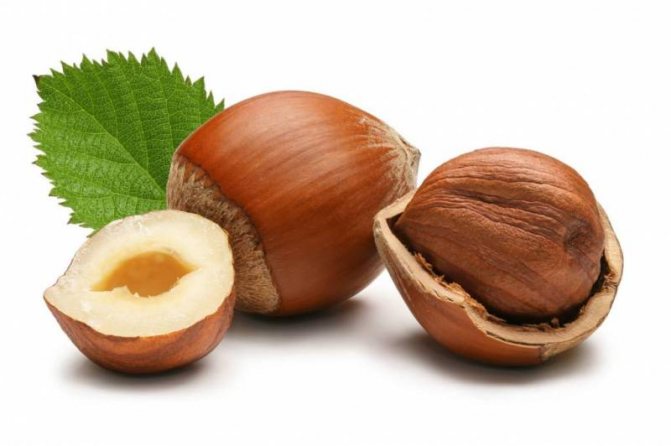
Nuts contain palmitic, oleic and stearic acid. They reduce the risk of cardiovascular pathologies and stimulate mental activity.
Benefits of hazelnuts
Nuts contain many nutrients that have a positive effect on the body of the mother and baby. Hazelnuts during breastfeeding promote:
- improving the lactation process;
- strengthening the immune system, preventing infections;
- prevention of cancer;
- restoration of metabolism;
- fatigue and increased mood;
- improving the functioning of the heart and blood vessels;
- normal growth and development of the baby;
- cancer prevention;
- improving the condition of the skin;
- cleansing the body of harmful substances.

Can you eat hazelnuts while breastfeeding? The main benefit is improving the composition and nutritional properties of mother's milk. The nut saturates the body with iron and other micro- and macroelements. Its use will speed up the recovery process of the body in women who have recently given birth to a baby.
No or yes
Can a nursing mother use hazelnuts in her diet? Pediatricians do not have a clear answer, but many are inclined to favor its use.
- Firstly, the nut is generally well tolerated by infants in breast milk.
- Secondly, the product has a rich group of useful components, which allows the mother to feel better and the baby to develop harmoniously.
Therefore, you can eat hazelnuts during lactation, but subject to some restrictions. To understand the issue, it’s worth getting to know the pros and cons of nuts in more detail.
Mothers who are breastfeeding more than their first baby know that strict dietary restrictions relate mainly to excessively fatty foods, smoked foods, pickles and exotic fruits. Otherwise, when the child does not suffer from allergies, it is possible, of course, to diversify the diet within reasonable limits, provided that the usual diet is maintained.

Mothers who are breastfeeding must plan their diet very carefully.
Harm from nuts
Can you eat hazelnuts while breastfeeding? If consumed in doses that exceed the daily norm, the nut can cause:
After all, the nutritional value of hazelnuts (100 g) is 704 kcal.
The product is difficult to digest. When eating hazelnuts during breastfeeding, they complicate the digestion process. A woman may experience bloating.
To achieve only benefits from nuts, you need to consume them in acceptable quantities. It can also lead to an allergic reaction.
It is prohibited to eat hazelnuts in the following cases:
In such situations, a nursing mother should completely avoid eating hazelnuts.
Allowed nuts while breastfeeding
All varieties contain a number of useful microelements and substances for humans, and when breastfeeding, it is better to replace some types with safer ones. So, the following varieties are distinguished:
Walnuts
The most useful type during lactation. Due to its saturation with antioxidants, it strengthens the immune system and helps fight colds. The favorable combination of vitamin E and omega-3 acid is effective for sleep disorders, for restoring the nervous system, and also improves blood pressure.
Walnut kernels are rich in calcium, which makes them an indispensable product for a nursing woman, because this is one of the most important elements for restoring women's health during the period of breastfeeding.
At the same time, the myth that consuming this variety increases lactation should be dispelled. In fact, the quality of breast milk simply improves, it becomes more nutritious, which is why the baby seems to be full much faster.
Pine nuts
Most of the others contain iodine, phosphorus, manganese and copper. They are absorbed in the body faster and more than others. They will not add any special calorie or fat content to milk, but a nursing woman will definitely receive the necessary nutrients when consuming this variety.
Hazelnuts and almonds
They help fight the depleted condition of nails and hair, stabilize the amount of proteins and fats in the mother’s body, and also enrich the diet with calcium and magnesium, which is also beneficial for bone tissue.
Pistachios
Naturally, we are not talking about packaged, salty snacks, but about fresh nuts. Rich in fiber, which is so necessary for smooth digestion. The carotenoids and lutein they contain have a beneficial effect on vision.
Peanut
Not only is it well absorbed, but it contains folic acid and amino acids that are beneficial during pregnancy. Recommended for preventive purposes against cardiovascular diseases, and also normalizes the functioning of nerve cells.
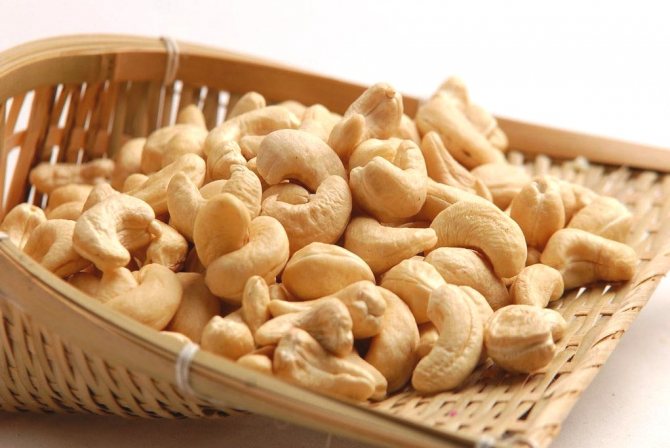
Cashews are also one of the most recommended varieties of nuts for breastfeeding, which should be consumed dried rather than fried, as it retains more useful substances.
Cashew
Helps restore the body after a hard, stressful day and active physical activity. The rich composition is dominated by such beneficial microelements as iron, zinc, omega-3, phosphorus, vitamins B and E. Recommended for the prevention of anemia and heart disease.
Quite new, but no less common Brazil nut
Contains selenium, vitamins A and B, potassium, iron, magnesium. In addition, it is famous for its high fat content (up to 60%), which means that just a small portion of this nut is suitable as a hearty and nutritious snack.
Negative effects on the child’s body
Is it possible to eat hazelnuts when breastfeeding a newborn? Due to the fat and protein content in nuts, infants may experience colic and an upset stomach.
The danger of taking hazelnuts is an allergic reaction, which usually manifests itself in the form of itching, skin rash, cough and runny nose.
The same person may have different reactions to nuts. Some species do not cause any unpleasant symptoms, while others, even in small quantities, can cause allergies. It manifests itself as skin rashes and digestive disorders. If you are intolerant, even a small trace of nuts in food is enough to cause Quincke's edema. It can develop quickly. Externally, the pathology manifests itself in the form of swelling of the face and neck. Quincke's edema is dangerous due to difficulty breathing and suffocation.
If you notice any of the above symptoms in your baby, you should immediately call an ambulance.

Can you eat hazelnuts while breastfeeding? If a child is intolerant to it, after the mother eats hazelnuts, the baby develops negative symptoms in the form of a rash. The occurrence of food allergies in an infant is affected by:
If you identify it quickly and exclude hazelnuts from your diet, the rash and spots will go away relatively quickly. But signs related to diseases of the gastrointestinal tract will bother the baby for another 1-2 weeks.
Contraindications
Despite the wide range of beneficial properties of hazel fruits, if consumed uncontrolled, they can harm the health of the mother and child and cause certain health problems.
In particular:
- Calorie content . The nut is a high-calorie product, with 704 kcal per 100 g of raw material. That is why consuming hazelnuts in large quantities can cause weight gain in the mother and the appearance of various problems with the digestive tract in the baby - colic, constipation or diarrhea, bloating.
- Allergenicity . As already noted, hazel is considered one of the most allergenic foods. Walnuts and almonds are “safer”, so doctors advise introducing them into the diet first. Consumption of hazelnuts often causes itching, rash, runny nose, digestive system disorders, and sometimes vomiting and cough in infants.
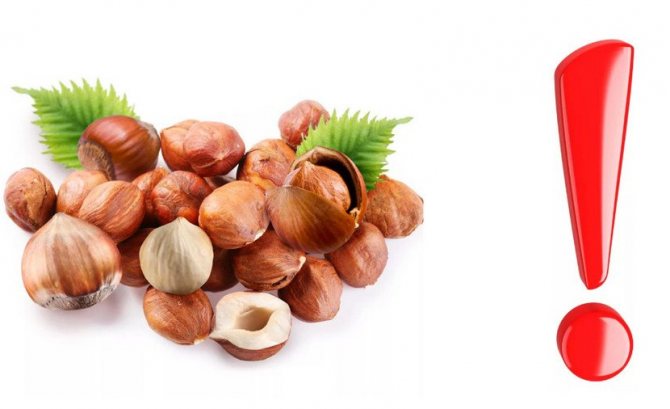
If you have at least one negative symptom, you should immediately stop eating nuts and consult an allergist. Typically, the symptoms of a food allergy go away in a baby 2-3 weeks after eliminating the product from the mother’s diet. But if the child has a strong immune system and the dose of the allergen was small, then the negative manifestations may disappear within 3–5 days.
When to try hazelnuts
You can add nuts to a breastfeeding woman’s diet 2-3 months after the birth of the baby. You need to start with 1 fruit, gradually increasing the rate of hazelnuts when breastfeeding to 8 pieces. in a day.
If the baby develops increased gas formation, other intestinal disorders, rashes and itching, the nursing mother will have to completely stop eating the nut.
A second attempt to introduce hazelnuts into the diet should be made 1 month after the signs of allergy disappear. If the woman herself is prone to such reactions, then this can be passed on to the child. Therefore, you should not try nuts before the baby is 6 months old.

Hazelnuts can be eaten in their pure form, as well as added to salads and baked goods. Women should not forget about the recommended daily dose.
Recipes to improve lactation
Walnuts are considered the most effective nuts for enhancing lactation; they increase the amount of milk and its nutritional value. Although doctors have not proven this effect of fruits on milk production, experienced mothers share tips and recipes that helped them establish and improve lactation:
- Nuts with milk is an effective and popular recipe among mothers. Pour 3-5 walnut kernels into 250 ml of milk at a temperature of 90-100 degrees. Leave until the milk cools to room temperature. Drink nut milk throughout the day in small sips between meals.
- Salad with raw carrots. Grate 1 medium carrot and mix with 2-3 chopped walnuts. Eat this salad, 0.5 teaspoon after meals.
- Vitamin mixture with honey and oil. Pour 0.5-1 cup of chopped nuts with honey, add 2 tablespoons of butter, stir. Eat 1 teaspoon per day. Before using this recipe, you must eat 0.5 teaspoon of honey for 5 days. This is a strong allergen, contraindicated for many infants. Therefore, be careful and careful.
If you are experiencing difficulties with lactation, try the recipe for walnuts with milk, it is the most effective. These recipes should be used no earlier than the child turns 2 months old and after the mother has tested each component separately for 5-7 days.
Is it possible to eat nuts in the first month?
The first weeks after the birth of a baby are considered an adaptation period when he gets used to the world around him. The baby is particularly sensitive to external influences. It is at this time that his digestive system begins to form. Therefore, it is especially important that the nutrition of a nursing mother is safe.
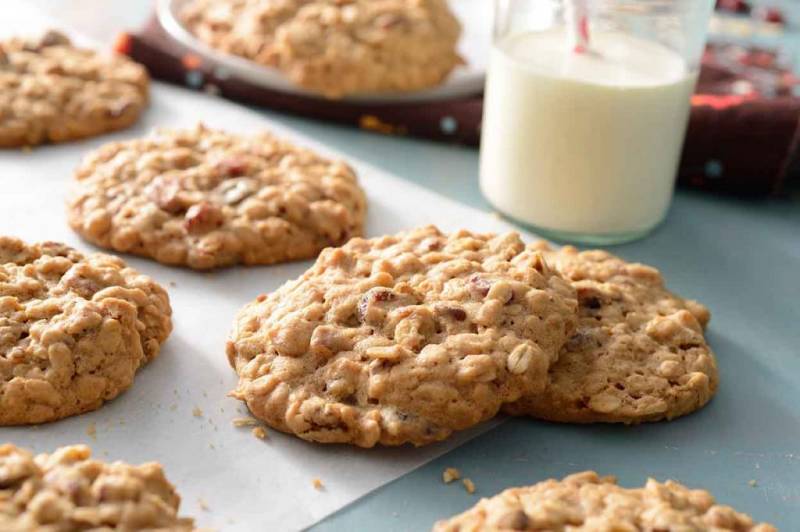
It is best for a woman to follow a strict diet for 1-2 months after giving birth. And then it is allowed to introduce new products, but gradually. It is advisable to introduce hazelnuts into the diet 5-6 months after the birth of the baby.
Due to the fact that the nut is an allergen, eating hazelnuts during breastfeeding is prohibited in the first month.
Rules of consumption
There are certain rules and regulations for hazelnut consumption while breastfeeding. Do not forget that a child’s body has individual characteristics. The main thing is attention to the baby’s well-being.
Before you start including hazelnuts in your diet, you need to choose a quality product. Nuts are available in shell or shelled.
For women, it is best to buy hazelnuts in shell. Before use, nuts must be dried in the oven. As a result, the shell will be removed faster, and the nuts will have an enhanced forest aroma.
If hazelnuts have a bitter taste, they should not be consumed. This indicates improper storage of the product. If mold and fungi are found, which are sources of carcinogens, the nuts should be thrown away.
How to correctly introduce hazelnuts into the menu:
Before inclusion in the diet, you need to test for allergic reactions. To do this, use 1 nut. The baby's well-being is monitored for 2 days. If he does not have stomach problems or allergic reactions, then he can include hazelnuts in the menu of a nursing mother.
If within 2 days the child has a negative reaction, then the introduction of the nut into the diet is postponed for another 1 month.
If the second attempt is successful, the woman can gradually increase her consumption of hazelnuts to 6-8 pieces per day. It is prohibited to eat more than 20 grams per day.
A nursing mother is allowed to add hazelnuts to salads, desserts and main courses. This will allow you to diversify your diet, make it tasty and healthy. You can prepare simple and special dishes.
Recipes for dishes with hazelnuts for nursing mothers
Hazelnuts can be consumed separately or used in the preparation of desserts and salads, main courses and salads. Recipes with nuts will diversify the menu during breastfeeding and add an interesting and original taste to dishes. However, remember that during lactation, doctors do not recommend consuming several varieties of nuts at once and eating more than 8 hazelnuts per day.
Lenten sweets made from dried fruits with hazelnuts
An excellent treat for nursing mothers that does not contain oil, eggs or other high-calorie and allergenic foods. These sweets are an excellent substitute for sweets that are prohibited during breastfeeding. To prepare you will need:
- Prunes – 50 g;
- Dried apricots – 50 gr;
- Light raisins – 30 g;
- Hazelnuts – 10 nuts.
Rinse the dried fruits and soak in warm water for one hour. Then dry the fruits and pass through a blender or meat grinder. One half of the nuts should be coarsely ground in a coffee maker or blender, the other half should be left whole. Visually divide the dried fruit mass into five equal parts. Cover each whole hazelnut with a mass, and then roll in chopped nuts. To prevent the mixture from sticking, wet your hands in cold water each time.

Oatmeal cookies with banana and hazelnuts
- Oatmeal – 1 cup;
- Bananas – 2 pieces;
- Chopped hazelnuts – 2 tbsp. spoons;
- Raisins – 2 g;
- Sugar – 2 tbsp. spoons.
Mash the bananas until smooth, sprinkle with sugar and oatmeal. Knead the dough, add chopped hazelnuts and washed, dried raisins. Mix the mixture and form cookies of any shape. Place on baking paper pre-greased with butter. Bake for 20 minutes. These are light and dietary cookies for a nursing mother. By the way, you can use dark chocolate instead of raisins.
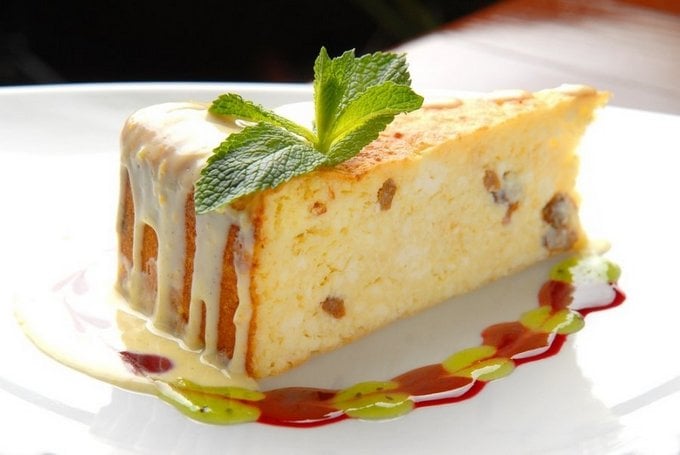
Curd casserole with hazelnuts
- Cottage cheese – 600 gr;
- Oatmeal – 75 g;
- Chicken eggs – 2 pcs.;
- Milk – 100 g;
- Hazelnuts – 30 g;
- Raisins – 30 gr;
- Sugar – 70 gr.
Mash the cottage cheese with a fork. It’s good if it’s homemade cottage cheese. This way you will be confident in the composition and shelf life of the product. It's easy to make cottage cheese at home. Read how to do this here. Add sugar to the mashed cottage cheese and grind until smooth. Break the eggs into the mixture and mix, add oatmeal and mix again. Pour in the milk, rinse the hazelnuts and raisins thoroughly, remove the skins from the nuts. Cut the fruits in half and add to the curd mass. Stir and place in a baking dish. Bake for 40 minutes at 180 degrees.
Apple-plum dessert with nuts
- Green apples without peel – 400 g;
- Plum – 400 gr;
- Lemon juice – ½ lemon.;
- Honey – 2 tbsp. spoons;
- Chopped hazelnuts – 2 tbsp. spoons.
Grate the apples and cut the plums into quarters. Add honey and sprinkle with lemon juice. Mix the ingredients thoroughly and sprinkle chopped nuts on top.
In addition, hazelnuts can sometimes be added to oatmeal and oatmeal porridge.
You will find even more delicious and healthy recipes for nursing at the link /. Subscribe to our VKontakte group
How to choose hazelnuts
The nut that a woman includes in her diet must be of high quality. It is best to buy hazelnuts in shells. When pouring nuts, it makes a sound reminiscent of knocking. The hazelnut shell must be intact, without damage or contamination. It should also be dry, without the smell of dampness or rot.
It is not recommended to purchase pre-shelled nuts. Hazelnuts last longer in shells. The main conditions are a dark and cool place.

Hazelnuts during breastfeeding can bring many benefits to the body of mother and child. This occurs in the absence of allergies and negative effects on the gastrointestinal tract. Before starting to eat hazelnuts, a woman should test for an allergic reaction to this product in her baby.
Source: fb.ru










